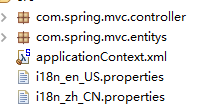SpringMVC国际化与文件上传
其实SpringMVC中的页面国际化与上一章的验证国际化基本一致。
1.对页面进行国际化
1)首先我们对Spring配置文件中添加国际化bean配置
<!-- 注册国际化信息,必须有id,指定资源文件名称,资源文件在src目录下 --> <bean id="messageSource" class="org.springframework.context.support.ResourceBundleMessageSource"> <property name="basename" value="i18n"></property> </bean> <!-- 配置LocalResolver用来获取本地化语言 --> <bean id="localeResolver" class="org.springframework.web.servlet.i18n.SessionLocaleResolver"></bean> <!-- 配置LocaleChanceInterceptor拦截器 --> <mvc:interceptors> <bean class="org.springframework.web.servlet.i18n.LocaleChangeInterceptor" /> </mvc:interceptors>
2)然后添加我们的资源文件,这个资源文件的前缀要与我们上面配置的bean的value相同。

我们在资源文件写入我们需要国际化的内容

然后我们在跳转页面的时候需要加载国际化资源
@RequestMapping(value="login",method=RequestMethod.GET) public String login(Locale locale,Map<String ,Object> map){ String name = messageSource.getMessage("name", null, locale); String pass = messageSource.getMessage("pass", null, locale); String title = messageSource.getMessage("title", null, locale); String submit = messageSource.getMessage("submit", null, locale); map.put("title", title); map.put("pass", pass); map.put("name", name); map.put("submit", submit); map.put("user", new User()); return "login"; }
我们在页面中可以使用jstl或者spring标签数据国际化信息,spring中的form标签是用来输入spring验证错误之后的提示信息(上章有提过)
<%@ taglib uri="http://java.sun.com/jsp/jstl/fmt" prefix="fmt"%> <%@ taglib uri="http://www.springframework.org/tags" prefix="spring" %> <%@ taglib uri="http://www.springframework.org/tags/form" prefix="form" %>
然后我们页面中的国际化信息可以可这显示出来
<form:form action="login" method="post" commandName="user"> <fmt:message key="name"/> <form:input path="username"/> <form:errors path="username"/> <br> <fmt:message key="pass"/> <form:input path="userpass"/> <input type="submit" value="<spring:message code="submit"/>"> </form:form>
我们还可以完成一个语言切换功能,我们在页面上加入两个超链接,当接收到请求,SpringMVC会在上下文中查找一个本地解析器,找到后使用它获取请求所对应的本地化类型信息,SpringMVC还允许还允许装配一个动态更改本地化类型的拦截器,这样通过指定一个请求参数就可以控制单个请求的本地化类型。
<a href="login?locale=zh_CN">中文</a> <a href="login?locale=en_US">英文</a>
SpringMVC接到请求后首先会判断有没有这个参数,如果有这个参数就添加到session里面,如果没这个参数会到session里面去找,session里面没有找到会默认读取浏览器的语言。
2.文件上传
SpringMVC的文件上传非常的简单,它直接提供了直接的支持,这种支持是通过即插即用的MultipartResolver接口实现的。Spring用它的实现类CommonsMultipartResolver来实现。SpringMVC上下文中没有自动装配所以需要我们手动来配置。我们这里就直接实现一个多文件上传,多文件上传会了害怕单文件上传不会?
配置之前我们首先来导入文件上传的jar包,这些包在我们spring中是没有的。

然后我们手动配置下Bean
<!-- 配置文件上传 --> <bean id="multipartResolver" class="org.springframework.web.multipart.commons.CommonsMultipartResolver"> <!-- 指定默认的编码格式 --> <property name="defaultEncoding" value="UTF-8" /> <!-- 指定允许上传的文件大小,单位Byte --> <property name="maxUploadSize" value="512000" /> </bean>
这个bean里还可以设置类型啊什么什么的,有需要的可以阅读源码。
<form action="${pageContext.request.contextPath}/upload" method="post" enctype="multipart/form-data"> <input type="file" name="file"/><br> <input type="file" name="file"/><br> <input type="file" name="file"/><br> <input type="submit" value="submit"> </form>
enctype="multipart/form-data" 注意文件上传必须加上这个,而且必须是post请求。
然后我们来看下我们服务器是怎么接收到文件的,多文件上传使用 MultipartFile[] 并且一定要在参数前加上注解 @RequestParam("file")否则会报错。单文件上传我们只需要使用一个MultipartFile对象,并且无需加注解。
/** * 单文件上传 : MultipartFile file * 多文件上传 : @RequestParam("file") MultipartFile[] file * 多文件上传必须加上 @RequestParam("file")注解否则会报错 * @author:MiYa. * @time:2018-9-28 11:50 */ @RequestMapping(value="upload",method=RequestMethod.POST) public String testFileUpload(HttpServletRequest request , @RequestParam("file") MultipartFile[] file){ for (int i = 0; i < file.length; i++) { MultipartFile multipartFile = file[i]; System.out.println(" ContentType: " + multipartFile.getContentType()); System.out.println(" Name: " + multipartFile.getName()); System.out.println(" OriginalFilename: " + multipartFile.getOriginalFilename()); System.out.println(" Size: " + multipartFile.getSize()); //判断是否提交文件,如果没有那么跳过上传 if(multipartFile.isEmpty()){ continue; } // 获取文件的上传路径 String uploadpath = request.getServletContext().getRealPath("uploads"); //获取文件名称 String filename = multipartFile.getOriginalFilename(); //截取文件后缀 String fileext = filename.substring(filename.lastIndexOf(".")); //生成新的随机文件名称 String newfileName = UUID.randomUUID() + fileext; //文件保存路径 File savepath = new File(uploadpath + "/" + newfileName); //上传文件 try { multipartFile.transferTo(savepath); } catch (IllegalStateException e) { e.printStackTrace(); } catch (IOException e) { e.printStackTrace(); } } return "welcome"; }
整理下MultipartFile经常使用的方法:
isEmpty():判断是否提交文件上来
getContextType():获取文件类型
getName():获取表单元素名称
getOriginalFilename():获取文件名
getSize():获取文件大小
getBytes():获取字节数组
作者: 日落西风又在吹
出处:https://www.cnblogs.com/SimpleWu/p/9717853.html
本站使用「SimpleWu BY 4.0」创作共享协议,转载请在文章明显位置注明作者及出处。




【推荐】国内首个AI IDE,深度理解中文开发场景,立即下载体验Trae
【推荐】编程新体验,更懂你的AI,立即体验豆包MarsCode编程助手
【推荐】抖音旗下AI助手豆包,你的智能百科全书,全免费不限次数
【推荐】轻量又高性能的 SSH 工具 IShell:AI 加持,快人一步